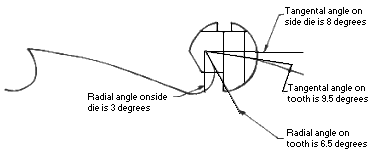Filers usually want to shape their saws to tangential and radial angles that are parallel to the final grinding angles they have chosen. To do that, just find the grinding angles you prefer in the two left hand columns of the chart below and then order side dies (shaper jaws) for your No. 6900-B Armstrong shaper with the angles shown in the two right hand columns. Always specify the gullet depth, plate thickness and desired kerf after shaping when ordering side dies.
Side Grinder Angles |
Shaper Side Die Angles |
||
Tangential |
Radial |
Tangential |
Radial |
5 |
2 or 3 |
5 |
0 |
6 |
2 or 3 |
6 |
0 |
7 |
2 or 3 |
6 |
0 |
8 |
2 or 3 |
7 |
0 |
Note: All calculations are based on a 30 degree hook angle and 12 degree back clearance angle. If your preferred side grinder angles are not listed, then contact Armstrong. Please identify the hook angle and back clearance angle of your saw teeth.
Why must the shaper side die angles be smaller than the side grinding angles? Because both the tangential and radial angles on the shaper side dies are measured differently from these same angles on a side ground tooth.
The sketch below shows a typical band saw tooth superimposed on the outline of a pair of No. 6900-B shaper side dies. The standard angles on these side dies would be 8� tangential x 3� radial. Notice the 8� tangential angle on the side dies is measured straight back, parallel to the sawing line. The 3� radial angle on the side dies is measured straight down, at a right (90� ) angle from the tangential angle. The tangential and radial angles on all side dies are measured using this right angle grid reference.
After side grinding, these angles are measured on the tooth itself. The tangential angle is measured along the back clearance of the tooth while the radial angle is measured on the hook line.

As shown on this sketch, the side die angles of 8� tangential x 3� radial are equal to the side ground angles of 9.5� tangential x 6.5� radial on the tooth.
A typical 15 gauge (1.82 mm) band saw that is to be swaged, shaped, sharpened and finally side ground would be shaped with side dies ground to 6� tangential x 0� radial x .039" (1 mm) clearance per side. This saw would have .150" (3.8 mm) kerf after swaging, shaping and sharpening. The side grinder would be set to grind each tooth to 7� tangential x 3� radial angles x .130 (3.3 mm) kerf in one pass.